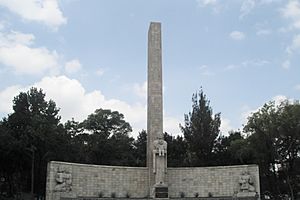Luis Ortiz Monasterio facts for kids
Quick facts for kids
Luis Ortiz Monasterio
|
|
|---|---|
| Born | August 23, 1906 |
| Died | February 16, 1990 (aged 83) |
| Nationality | Mexican |
| Education | Academia de San Carlos |
| Known for | sculpture |
Luis Ortiz Monasterio (born August 23, 1906, in Mexico City – died February 16, 1990, in Mexico City) was a famous Mexican sculptor. He was known for his very large and impressive sculptures. Some of his most famous works include the Monumento a la Madre (Monument to Mothers) and the Nezahualcoyotl Fountain in Chapultepec Park. In 1967, he won the Premio Nacional de Artes, a top award for artists in Mexico. He was also one of the first members of the Academia de Artes.
Life of a Sculptor
Luis Ortiz Monasterio (his full name was Luis Ortiz Monasterio del Campillo) was born in Mexico City. Sadly, his father passed away in the same year he was born.
In 1920, when he was about 14, Luis took a course to become a teacher. At the same time, he studied drawing at night at the Academy of San Carlos. Later, he officially joined the academy. He focused on engraving, drawing, and especially sculpture.
Because his family needed money, he moved to Los Angeles, USA. There, he worked and continued his studies. He discovered the amazing works of famous sculptors like Auguste Rodin and Brâncuși. In 1927, he joined a special workshop in Mexico City. This workshop encouraged artists to sculpt Mexican themes and values using local stone.
For several years, he lived in both the United States and Mexico. Eventually, he settled permanently in Mexico City. Besides being an artist, Luis also wrote books and articles. These writings often included deep thoughts about philosophy and poetry.
Luis Ortiz Monasterio stopped sculpting in 1989. He passed away a year later, at 83 years old, in Mexico City. His body was cremated at the Panteón de Dolores in Mexico City.
His Amazing Career
Luis Ortiz Monasterio worked as a sculptor for over sixty years. He is considered one of the most important Mexican sculptors of the 20th century. He was active during a time when Mexican mural painting was very popular. He is one of the few sculptors from that era who is still remembered today.
He began his career in 1927 as a drawing teacher. This was after he returned from his studies in the United States. He taught at the Escuela de Maestros Contructores. He also taught for many years at the Escuela Nacional de Artes Plásticas (ENAP) from 1939 to 1962. He also taught at La Esmeralda.
In 1928, Ortiz Monasterio went back to Los Angeles to focus on sculpting full-time. He had his first solo art show at the Book Shop Gallery. Later, he had another show at Gump’s Art Gallery in San Francisco. In the 1930s, he created many sculptures that became famous. These works were known for their unique shapes and textures. Some of them include El soldado herido (The Wounded Soldier) from 1932 and La Victoria (Victory) from 1935.
His success in the United States brought him back to Mexico. He started getting requests to create very large, monumental sculptures. One of his first big stone carvings was El llamado de al revolución (The Call of the Revolution), made between 1932 and 1934. Other important works include the reliefs for the Benemérita Escuela Nacional de Maestros. He also created the Monumento a la Madre in Parque Sullivan in 1948. The Nezahualcoyotl Fountain in Chapultepec Park is another one of his famous works.
Luis Ortiz Monasterio received his first award for sculpture in 1946. In 1967, he won the prestigious Premio Nacional de Artes. In 1968, he helped start the Academia de Artes. He also received an award for his long teaching career at ENAP. After he passed away, there were art shows to honor his work. One was in 1992 and another in 2011.
Sadly, about fifteen percent of his artwork is now missing or destroyed. Many of his other works, especially the large outdoor sculptures, are in poor condition.
His Artistic Style
Ortiz Monasterio was part of a group of Mexican sculptors. This group included artists like Oliverio Martínez and Federico Canessi. They used ideas from Art Deco and Cubism in their art. They often showed figures of working-class people and indigenous populations.
His art style is known for using classic and geometric shapes. It also shows influences from ancient Mexican cultures, known as pre-Hispanic art. He was also inspired by a Yugoslav artist named Ivan Mestrock. Luis Ortiz Monasterio used ideas from numerology and Pythagorism in his works. He also included deep, spiritual concepts from the Aztec and Mayan cultures.
His work can be divided into two main types. The first type includes large public sculptures that tell historical stories. Examples are the Nezahualcoyotl Fountain in Chapultepec (1956). The second type includes his smaller works. These often show beautiful human forms or have a mechanical feel to them.
See also
 In Spanish: Luis Ortiz Monasterio para niños
In Spanish: Luis Ortiz Monasterio para niños



